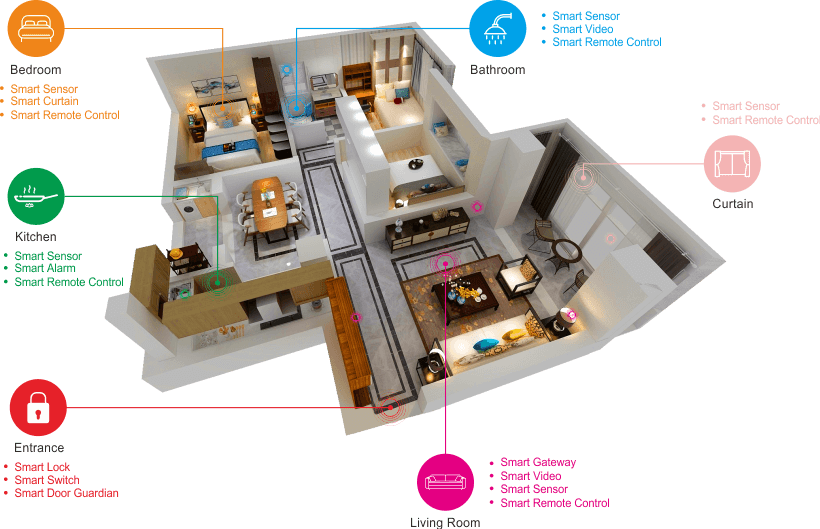The term “smart home” is everywhere these days, but for many people, it sounds confusing—or even intimidating. Do you need a degree in technology to set one up? Do smart devices actually make life easier, or are they just a gimmick? The truth is, a smart home doesn’t have to be complicated. With the right approach, anyone can enjoy the convenience, security, and efficiency that smart devices offer. Let’s break it down in simple terms.
What Is a Smart Home?
A smart home is a house equipped with devices that can be controlled remotely or automated. These devices connect to the internet and can communicate with each other, your smartphone, or even your voice assistant.
Examples of smart devices include:
- Smart lights – Turn on/off or dim lights using your phone or voice commands.
- Smart thermostats – Adjust temperature automatically based on your routine.
- Smart security cameras and door locks – Monitor your home and control access remotely.
- Smart plugs and appliances – Turn on devices or schedule them to operate automatically.
In essence, a smart home is about making everyday tasks easier, safer, and more energy-efficient.
Why a Smart Home Can Be Useful
Many people think smart homes are just flashy gadgets, but there are practical benefits:
- Convenience: Control lights, locks, and appliances from anywhere using a smartphone or voice assistant.
- Energy Efficiency: Smart thermostats and lights reduce energy waste by adjusting automatically.
- Safety: Smart security systems alert you to unusual activity and allow you to monitor your home remotely.
- Accessibility: For elderly or differently-abled individuals, smart homes can make daily tasks easier.
- Integration: Smart devices can work together. For example, your security system can turn on lights if it detects motion.
How Smart Home Devices Work
Most smart home devices work in one of three ways:
- Wi-Fi Connected Devices: These connect directly to your home Wi-Fi. Your phone or a voice assistant communicates with them over the internet. Example: Smart bulbs or cameras.
- Hub-Based Systems: Some devices require a central hub to connect all devices. Hubs act as a bridge, allowing different devices to work together. Example: Smart security systems or Zigbee/Z-Wave devices.
- Voice Assistants: Platforms like Alexa, Google Assistant, or Siri allow you to control devices using simple voice commands. For example, saying “Turn off the living room lights” can do exactly that.
Getting Started Without Feeling Overwhelmed
If you’re new to smart homes, it’s easy to feel confused by the endless options. Here’s a step-by-step approach:
Step 1: Start Small
Begin with one or two devices that solve a real problem. For instance:
- Smart plugs for lamps or coffee machines.
- A smart thermostat to save on energy bills.
Starting small helps you learn the system without getting overwhelmed.
Step 2: Choose a Platform
Most smart devices work with Amazon Alexa, Google Assistant, or Apple HomeKit. Pick one platform that fits your needs and stick with it. Mixing platforms can be confusing.
Tip: If you already own a smartphone, consider the platform that integrates best. iPhone users may prefer Apple HomeKit; Android users may prefer Google Assistant.
Step 3: Use Automation
Once devices are connected, take advantage of automation. Examples:
- Lights that turn on at sunset.
- Thermostats that adjust when you leave or arrive home.
- Security cameras that send alerts if motion is detected.
Automation saves time and reduces the need for constant manual control.
Step 4: Keep Security in Mind
A smart home is connected to the internet, which means it could be vulnerable if not secured properly. Basic tips:
- Use strong, unique passwords for each device.
- Enable two-factor authentication if available.
- Keep software and apps updated.
- Avoid using public Wi-Fi for controlling your devices remotely.
Step 5: Expand Gradually
After you’re comfortable with a few devices, you can expand your smart home. Popular additions include:
- Smart doorbells to see who’s at your door.
- Smart cameras for indoor and outdoor security.
- Smart speakers for music and voice control.
- Smart appliances like refrigerators, washing machines, or ovens.
The key is to expand gradually rather than trying to automate everything at once.
Common Misconceptions
- Smart homes are expensive: While high-end devices exist, many affordable options work well. Start small and upgrade over time.
- They are difficult to use: Modern devices are designed for non-tech users with simple apps and voice controls.
- They are not secure: With proper setup and security practices, smart homes can be very safe.
- They replace traditional systems: Smart devices enhance, not replace, traditional appliances and systems.
Benefits Beyond Convenience
A smart home doesn’t just make life easier—it can save money and improve safety:
- Energy Savings: Smart thermostats and lights can reduce electricity bills by adjusting usage based on habits.
- Peace of Mind: Remotely monitor your home while away on vacation.
- Accessibility: For seniors or people with mobility challenges, smart devices can help with tasks like turning on lights or locking doors.
Final Tips for a Non-Tech Audience
- Focus on needs, not gadgets: Buy devices that solve real problems.
- Stick to one ecosystem: It reduces complexity and compatibility issues.
- Learn one device at a time: Avoid installing everything at once.
- Plan for the future: Consider devices that can expand as your smart home grows.
- Ask for help if needed: Most devices come with simple manuals and online tutorials.
Conclusion
A smart home doesn’t have to be confusing, expensive, or intimidating. By starting small, focusing on essential devices, and gradually expanding, anyone can enjoy the benefits of convenience, security, and energy efficiency.
Remember, the goal isn’t to have the flashiest gadgets—it’s to make life easier. With a little patience and the right approach, you can create a smart home that works for you, rather than the other way around.
